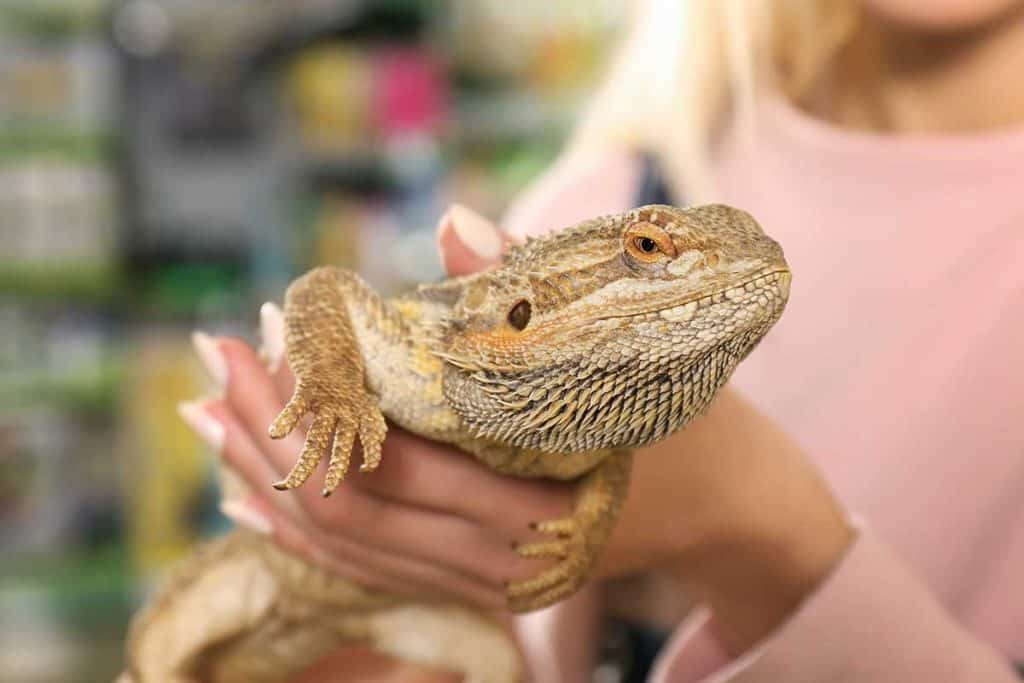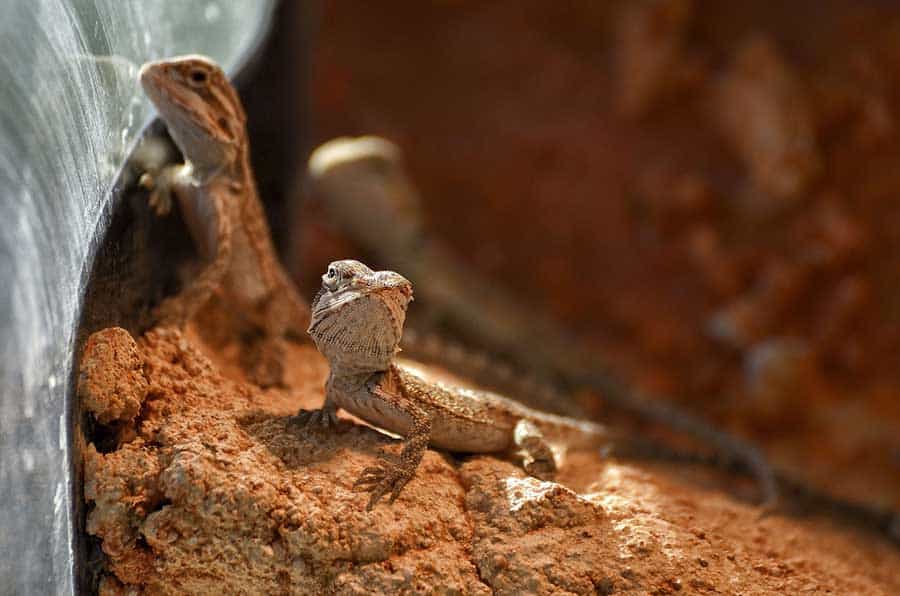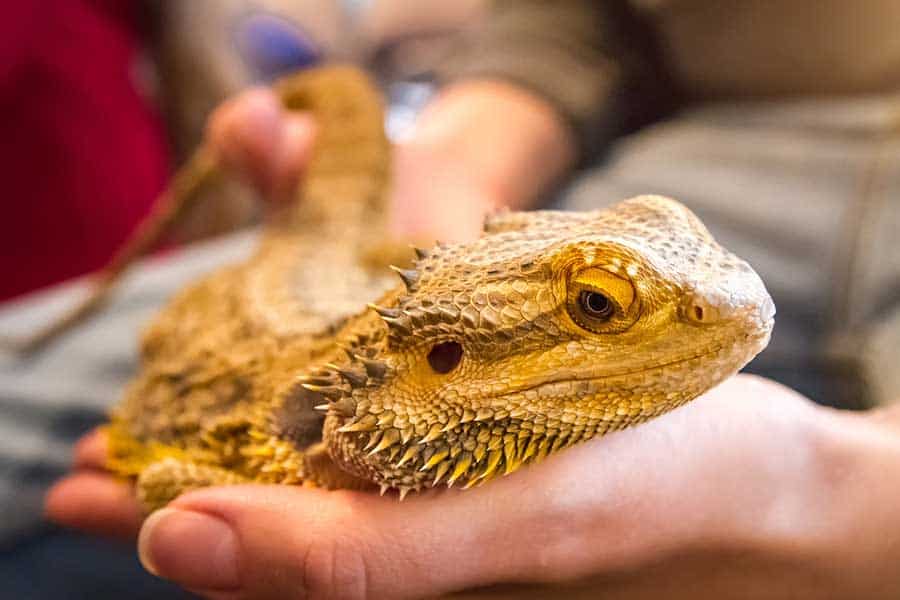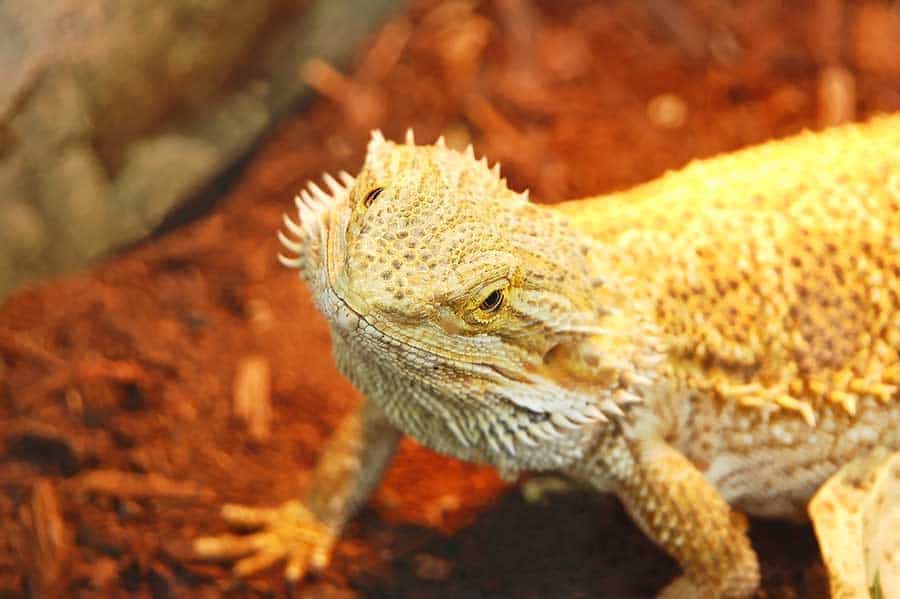Bearded dragons are very popular pets! They are friendly, intelligent, and easy to take care of, even for beginner reptile enthusiasts! Bearded dragon care is simple to set up and simple to maintain once you have everything in order, such as their enclosure, lamps, and decor.
To know how to properly care for your bearded dragon, you need to know a bit about their needs first. Bearded dragons need different things in their enclosures and in their diet depending on their age. These delightful lizards also come in many different shapes, morphs, and sizes, many of which have slightly different care requirements.
One of the best parts of owning a bearded dragon is they enjoy being handled by and interacting with humans! There are specific ways you should handle your bearded dragon to ensure their comfort and both of your safety. We’ll cover how to handle your beardie as well as how to feed and care for them.
There are also a few key factors that need to be considered when setting up your bearded dragon’s enclosure. These include the size of the enclosure, substrate type, heating, lighting, humidity, and enclosure decorations for enrichment.
Much of their enclosure setup — such as their heat and UVB lamps — have very specific settings, and you need to have various timers, thermostats, and gauges to monitor them.
Bearded Dragon Growth Stages: The Basics
Bearded dragons are native to Australia, but they were exported to various countries as pets starting in the mid-1990s. The bearded dragons that are available in the United States of America are all captive-bred. Captive-bred means they are not caught in the wild. Bearded dragons can be found in pet shops and from online and local breeders.
Bearded dragons have four distinct growth stages: hatchling, juvenile, sub-adult, and adult. Here are some details you should know about each stage of your new scaly friend’s life.
Hatchling
Bearded dragons from birth to two months old are considered to be hatchlings. During this stage, they are very small and very delicate. Breeders will usually not sell bearded dragons when they are this young, as many complications can arise with their health during this time.
Hatchlings are roughly two to three inches in length. They are very small and fragile during this time! They also only weigh around four or five grams as hatchlings. It is crucial to handle your beardie carefully if you have purchased them at this age or have hatched them from an egg yourself.
Juvenile
Beardies who are 2 to 9 months old are considered to be juveniles. During this stage of life, they grow incredibly quickly and eat protein like it is going out of fashion! Juvenile dragons need lots of insect protein to accommodate their fast metabolisms and rapidly growing bones and muscles.
Learn more about baby bearded dragon care here.
When your bearded dragon enters its juvenile stage, it will grow at a rate of 1.5 inches a month and increase by around 40 to 50 grams. Watch out for the rapid increase in appetite! Juveniles need lots of insect protein and frequent feedings to facilitate their rapid growth during this stage.
Subadult
Bearded dragons that are between 9 and 18 months are called subadults. In this third stage of life, their growth rate begins to slow down, and their diet starts switching over to resemble what they will eat as adults.
At this point, your beardie will need to start eating more greens, other veggies, and fruits, and less insect protein. They are now nearing their full adult size.
Subadult bearded dragons will reach their sexual maturity between 10 and 18 months, and during this time, their growth slows down a bit in terms of gaining length. However, they will continue to broaden and put on healthy weight.
At this point, it is a good idea to introduce more greens and veggies into your beardie’s diet to give them plenty of nutrients as they grow into their adult size.
Adult
From 18 months and on, your bearded dragon is considered an adult. Bearded dragons live on average for 10 to 15 years when raised in optimal conditions. However, some beardies have been known to live up to 20 years!
Adult beardies measure in at around 20 to 24 inches in length and will weigh between 380 and 470 grams. If your bearded dragon is longer than average, then their weight will typically be higher as well. This is when your bearded dragon reaches their full size and stops growing.
For a more in-depth look at growth rates and the many factors that affect a bearded dragon’s growth, check out our guide on how big bearded dragons get!
Coloration and Appearance
Most bearded dragons are usually a tan or brown color. They have darker brown speckles on them that create a dark pattern along their backs and down their sides. This pattern is intended to break up their shape in the wild so they are not easily spotted by predators.
Bearded dragons have been selectively bred to have certain colors. These are called morphs or “fancy” bearded dragons. Check out our guide on the differences between fancy bearded dragons and normal bearded dragons.
These fancy bearded dragon morphs can range in color from bright orange, to completely black, to almost translucent! Some bearded dragons even have a different texture, such as shorter spines or completely smooth skin. However, their skin color and texture can change their care needs to a certain extent.
For example, leatherback and silkie morphs need to be carefully monitored when it comes to the lighting and heating in their enclosures because selective breeding has made their skin very thin and susceptible to burns.
Handling Your Bearded Dragon
Bearded dragons that are properly socialized and handled from a young age absolutely love to be handled and greatly enjoy interacting with humans! They are one of our top picks when it comes to choosing a lizard that likes to be touched. Here are some tips to keep in mind:
- Handling a bearded dragon needs to be done carefully because they are much smaller and therefore delicate than you. Their bones can break easily if you are too rough with them, or if you drop them.
- It is a good idea to get your bearded dragon used to your presence before you start touching them directly. For example, place your hand in their enclosure near them for 5 to 10 minutes at a time or gently stroke them before working up to picking them up.
- When you finally attempt to pick up your bearded dragon, put your hand into their enclosure so that they can see it. Once they are aware of your presence, approach them from the side and scoop them up from underneath them. This means you will have a firm grip on their belly and are already supporting their full weight.
- Be sure to never grab them from above. This is what their natural predators do, and it will trigger a stress response from them if you hover over them in any way. This means they could bite or claw at you defensively.
- When you are done handling your bearded dragon, gently place them back inside their enclosure; do not just drop them in. With consistent and gentle handling, they will come to associate handling and you with excitement rather than discomfort.
- Always handle your bearded dragon when sitting down or over a cushioned surface that is not too high off the ground. This is because bearded dragons are a bit skittish at first, so they sometimes like to make a break for it when they get spooked. If they fall to the ground from a great height, they will injure themselves.
Dietary Needs
Bearded dragons are omnivores with very diverse appetites. This means they eat a mixture of insect-based protein, like crickets and superworms, and vegetation in the form of greens, vegetables, and fruits.
As hatchlings and juveniles, the ratio of plant matter to insect protein should be 20% plant matter and 80% insect protein. However, adults need a diet that is 80% plant matter and 20% insect protein. As your beardie ages, you will gradually need to shift this ratio.
Next, we’ll cover what specific foods you should be offering your bearded dragon when it comes to both food groups.
Plant Matter
Diversity in vegetation is important. Bearded dragons can eat a variety of leaves, greens, vegetables, fruit, and flowers.
It is best to prioritize dark, leafy greens and veggies and keep their fruit intake to a minimum, as fruit is very high in sugar and can rot their teeth and cause obesity over time.
Leafy Greens:
- Escarole
- Dark lettuces
- Collard greens
- Dandelion greens
- Mustard greens
Other Vegetables:
- Carrots
- Bell peppers
- Yellow squash
- Orange squash
- Zucchini squash
Fruit and Flowers:
- Strawberries
- Blueberries
- Blackberries
- Grapes
- Watermelon
- Sweet melon
- Zucchini flowers
- Dandelion heads
- Rose petals
Again, keep in mind that fruit should be used as an occasional treat item and should not be given to your bearded dragon more than once or twice a week.
Insect Protein
Beardies need plenty of protein in their diet, especially when they are still under one year of age. This protein usually comes from insects like crickets and mealworms because they are cheap, easy to keep, and are small enough to feed baby bearded dragons yet large enough for adults to enjoy them, too.
However, it is a good idea to also keep the protein portion of their diet varied so they do not become bored with eating.
Alternatives to Crickets Include:
- Dubia roaches
- Hornworms
- Phoenix worms (also known as NutriGrubs or black soldier fly larvae)
- Mealworms
There are also a few other kinds of worms you can feed your bearded dragon as a treat a couple of times a week. These will offer them a fat and/or hydration boost. However, because of their high fat content, they should be limited, as they can cause obesity. They are great to use as salad toppers to encourage your beardie to eat their greens.
Treat Worms:
- Morioworms
- Butterworms
- Waxworms
- Superworms
Vitamin Supplements
Bearded dragons need vitamin D and
You can use a powder or liquid
Check out our more detailed guide dedicated to what to feed your bearded dragon for a comprehensive analysis of all food items.
Common Health Problems
Like any pets, bearded dragons are prone to a range of health issues that you’ll need to keep an eye out for throughout their life. Here are the main health problems commonly affecting bearded dragons to look out for.
Obesity
Bearded dragons will always eat if there is food in front of them. This means they tend to overeat very easily. Overeating (even healthy foods like dark greens!) can and will lead to obesity.
If your bearded dragon weighs more than 550 grams without it being especially long or a German Giant morph, then they are considered obese, and their overall health needs to be closely monitored.
Obesity is a serious health issue because it puts pressure on the heart, lungs, liver, and other internal organs as well as your bearded dragon’s joints. Be sure to monitor your bearded dragon’s food intake closely. Additionally, weigh your beardie every week or two to address any sudden weight changes.
Metabolic Bone Disease
Metabolic bone disease occurs when there is not enough
Metabolic bone disease is not reversible, and it is eventually fatal if it becomes severe enough.
Fortunately, this disease can be avoided completely by providing your bearded dragon with a
Impaction
Impaction happens when there is a blockage in your bearded dragon’s digestive tract. This can be for a number of reasons. Sometimes, if your bearded dragon is too young to eat insects that are too large or have tough exoskeletons, then they can become impacted.
Alternatively, if your beardie is kept on a loose, non-digestible substrate such as sand or gravel and ingests small amounts of it over time, they can also become impacted.
Bearded dragons who are dehydrated will also become impacted because they do not have enough moisture in their system to aid in the process of digestion.
Finally, if the pieces of food you give to your beardie are too big for them to chew and digest properly, then they can become impacted. As a general rule, any pieces of food you offer to your bearded dragon should not be larger than the width of the space between their eyes.
Parasites
Internal parasites can come from poor quality food as well as poor quality breeders. Internal parasites need to be taken care of by an exotic pet veterinarian and medication.
External parasites such as mites can come from several places, including contaminated bedding or substrates as well as other reptiles that have parasites.
Mites can be dealt with by soaking your bearded dragon for 20 minutes and doing a full sanitation of the enclosure. Other parasites will need to be treated by a reputable reptile vet.
Enclosure Setup
One of the most important parts of bearded dragon care is enclosure size and setup. Bearded dragons need plenty of space, adequate heating, lighting, humidity, and plenty of tank decorations for enrichment. Here are some things to keep in mind when setting up your scaly pal’s new habitat.
Enclosure Size
Bearded dragons need a fair bit of space to roam because they are very active and energetic animals. Hatchlings and juveniles need an enclosure of at least 20 gallons.
Once your bearded dragon hits the six-month mark, their enclosure needs to be upgraded to a 40-gallon enclosure minimum. If their enclosure is not upsized, then they can suffer from being cramped and become stressed. Their activity will be restricted, and they can even stop growing altogether.
Bearded dragons are terrestrial rather than arboreal. That means they spend most of their time on the ground. Therefore, their enclosure needs to be longer and wider than it is tall.
Glass, plexiglass, or wood enclosures are all acceptable to use for a bearded dragon.
Substrate
A substrate is what goes on the bottom of the enclosure to catch all of the mess from your beardie’s food, poop, and shed skin.
Substrates made up of a lot of tiny, indigestible particles such as sand, gravel, or wood chips are not good for bearded dragons because they are known to eat the substrate when they are bored or stressed. Bearded dragons can also eat small amounts of substrate with their food accidentally, which will build up in their digestive tract over time.
In general, a solid, flat substrate is the best way to go, both to avoid impaction and because they are easier to clean.
Reptile carpet liners, for example, are reusable and washable. They are also relatively cheap and widely available at most pet shops and online retailers. The only downside to reptile carpet is that sometimes young bearded dragons can get their nails caught in it.
Newspaper and paper towels are also perfectly good substrates to use. They are very cheap and accessible. The only downside with these options is that they need to be replaced very regularly.
One of the best substrates to use are actual clay tiles or stick-down linoleum tiles. These substrates are easy to clean, look great, and retain heat well.
Check out our guide on the best substrate to use in your bearded dragon enclosure for more details.
Lighting
Bearded dragons need full-spectrum lighting in their enclosure, meaning they need both heat and UVB rays. The lighting is there to provide a photocycle, keep the enclosure warm, as well as substitute the UVB rays that the bearded dragon would ordinarily get from the sun in the wild.
A healthy photocycle to maintain is 12 hours of light and 12 hours of darkness each day. Bearded dragons are diurnal, so they need dark hours to rest and relax. During the daytime, they are more active and eat more.
Generally, it is best to use a UVB bulb with a 5% to 10% output for a bearded dragon enclosure. This is sometimes denoted as a decimal on the packaging, so a 5% output bulb may be listed as 5.0 instead.
Most bearded dragon owners opt for a UVB bulb and a separate basking bulb (anywhere from 50 to 80 watts or so) mounted above their pet’s enclosure, though some light bulbs are designed to provide both heat and UVB rays.
Temperature
Bearded dragons need a temperature gradient in their enclosure, with a very warm basking spot on one end and a cool area on the other end of the tank. They will move from warm to cool as needed to regulate their temperature. You create a gentle temperature gradient by using a heating element on one side of the enclosure.
You can use a ceramic heat emitter or a
The basking spot should sit at 90 to 95°F. The warm side of the enclosure should be around 80 to 85°F, and the cool side should sit at 75°F during the day and can drop to 70°F or so at night.
There should be a
Humidity
Bearded dragons come from Australia, so they are used to arid climates. They do not need high humidity levels.
Their humidity levels in a bearded dragon enclosure should sit between 20% and 40%. You can add humidity by misting the enclosure once or twice a day with plain cool water or lower the humidity by letting it dry out.
The enclosure needs to have a hygrometer in it to monitor the humidity levels.
If the humidity gets too high, then your bearded dragon can suffer from respiratory problems. However, if the humidity is too low, then your bearded dragon can become dehydrated very quickly.
Many hygrometers are combination thermometers, too. This saves space inside your enclosure.
Decorations
Bearded dragons are very active and curious creatures. They love to run around and climb on things. Therefore, they should have enrichment in their enclosure that allows them to move around and to get exercise.
Bearded dragons need a hide in their enclosure. The hide should be completely opaque. It should be large enough to fit your whole bearded dragon inside of it but small enough that it is snug and cozy for them when they’re feeling shy or want to take a nap.
Ideally, your beardie’s enclosure should have two hides. There should be a hide on the warm end and the cool end of the enclosure.
Hides are there to provide your bearded dragon with a place to run to when they are afraid, tired, or need to destress. The hide should be dark and quiet.
Finally, there should be some decorative pieces in the enclosure such as logs or branches so that your bearded dragon has forms of enrichment and other places to hide. Other decorations include rocks, hammocks, and bridges to climb on.
Top Bearded Dragon Care Tips
1. Set Up Your Bearded Dragon’s Enclosure Before Your New Baby Arrives.
Before your bearded dragon arrives, set up its enclosure! By setting up your bearded dragon’s enclosure beforehand, you get to perfect all of the different settings such as temperature and humidity without your beardie being in the enclosure and becoming stressed.
By setting up and running the enclosure for a couple of days before your bearded dragon arrives, you can check for any faults in the mechanical aspects, such as the temperature gauge or the heating elements.
2. Always Wash Your Hands Before Handling Your Bearded Dragon.
Reptiles are very susceptible to infections. People can transfer bacteria, parasites, and fungi between reptiles, other animals, and general surfaces. Whenever you are handling your bearded dragon, you must sanitise your hands.
If you notice that your bearded dragon has mites or other external parasites and they have come in contact with your clothing, then you need to change clothes before touching another pet.
3. Keep a Journal to Monitor Your Bearded Dragon’s Weight and Food Intake.
By keeping track of your scaly friend’s growth and what they’re eating, you’ll be able to notify your veterinarian if anything looks unusual. It can also help to track the temperature and humidity in case anything changes suddenly due to faulty bulbs or temperature/humidity gauges.
FAQs About Caring for a Bearded Dragon
I have never owned a reptile before. Can I manage a bearded dragon?
Yes you can! Bearded dragons are excellent choices for first time reptile owners. They are calm tempered, have easy care requirements, and they have wonderful, inquisitive personalities that will make you fall in love with caring for reptiles.
Can I house more than one bearded dragon in the same enclosure?
Bearded dragons, especially males, are very territorial. They do not like sharing their space with other bearded dragons. However, if you have an enclosure that is large enough, then you could house two or three female bearded dragons of the same size together.
For every bearded dragon you add to the enclosure, the enclosure needs to be increased by 10 gallons, and there needs to be an additional two secure hides in the warm and cool end of the temperature gradient. It isn’t recommended to cohabitate bearded dragons unless you have a lot of experience with raising them, though, as a lot of factors can go wrong.
Can I use a red light in my bearded dragon’s enclosure and leave it on all the time?
Bearded dragons can see the light from red light bulbs. This means that a red light that stays on for 24 hours a day will disrupt their photocycle and cause them to stress. It’s best to avoid red, blue, or other colored light bulbs; a simple white basking bulb is a much better option, as it more closely mimics natural sunlight.
Do I need a humid hide in my bearded dragon’s enclosure?
Bearded dragons do not need high humidity, so they do not need a permanent humid hide in their enclosure. However, when they shed their skin, they need a small boost in humidity to allow for a clean and easy shed.
The humid hide for when your beardie sheds can be a plastic container turned upside down with a hole cut into the side that is large enough for your bearded dragon to get through. Place some damp paper towels in the container on the warm side of the enclosure. Remember to remove the hide once your bearded dragon has finished shedding so the humidity in the tank doesn’t rise to an unsafe level.
At the Tail End of Things…
Bearded dragons are wonderful pets for experienced herp enthusiasts as well as first-time reptile owners. Bearded dragon care is simple and easy to manage once you get everything set up properly.
Bearded dragons need to have care that is tailored to their age to make sure they grow big and strong and remain healthy throughout their lives. Bearded dragons can live for up to 20 years, so caring for one is a long-term commitment!







